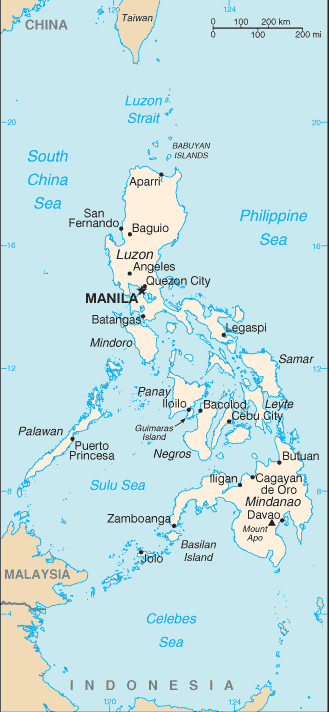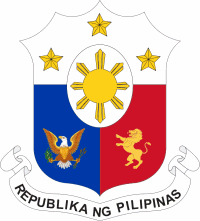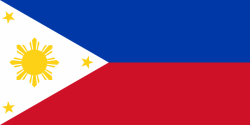Republic of the Philippines
Related Categories:

 Philippines Coat of Arms
Philippines Coat of Arms |
Flag, evolution of the flag, Anthem.
www.gov.ph/aboutphil/
The sun represents the dawning of a new era of self determination that was desired in 1897.
www.fotw.us/flags/ph.html Philippines - wikipedia.org
The Philippines became a Spanish colony in the 16th century, and then a U.S. colony after the Spanish-American War and the Philippine-American War.
en.wikipedia.org/
The majority of Philippine people are of Malay stock, descendants of Indonesians and Malays who migrated to the islands long before the Christian era. The most significant ethnic minority group is the Chinese, who have played an important role in commerce since the ninth century, when they first came to the islands to trade. As a result of intermarriage, many Filipinos have some Chinese and Spanish ancestry. Americans and Spaniards constitute the next largest alien minorities in the country.
More than 90% of the people are Christian; most were converted and became Westernized to varying degrees during nearly 400 years of Spanish and American rule. The major non-Hispanicized groups are the Muslim population, concentrated in the Sulu Archipelago and in central and western Mindanao, and the mountain groups of northern Luzon. Small forest tribes still live in the more remote areas of Mindanao.
About 87 native languages and dialects are spoken, all belonging to the Malay-Polynesian linguistic family. Of these, eight are the first languages of more than 85% of the population. The three principal indigenous languages are Cebuano, spoken in the Visayas; Tagalog, predominant in the area around Manila; and Ilocano, spoken in northern Luzon. Since 1939, in an effort to develop national unity, the government has promoted the use of the national language, Pilipino, which is based on Tagalog. Pilipino is taught in all schools and is gaining acceptance, particularly as a second language. Many use English, the most important nonnative language, as a second language, including nearly all professionals, academics, and government workers. In January 2003, President Gloria Macapagal Arroyo ordered the Department of Education to restore English as the medium of instruction in all schools and universities. Only a few Filipino families use Spanish as a first language.
The Philippines has one of the highest literacy rates in the East Asian and Pacific area. About 92% of the population 10 years of age and older are literate.
www.state.gov/r/
Introduction
About
Contact
Symbols in The News
Interpret this Symbol
AAC
African
AI
Alchemy
Alphabets
Ancient
Animal Symbolism
Architecture
Art
Articles
Astrology
Baha'i
Blissymbolics
Blueprint Symbols
Buddhist
Celtic Symbols
Cemetery
Chinese Symbols
Christian
Circle
City
Codes
Color
Conlangs
Crop Circles
Danger
Da Vinci Code
Designing Logos
Dictionaries
Dreams
Education
Egyptian Symbols
Electrical
Emoticons
Find Images
Fonts
Food
Fraternity
Hamsa
Healing
Heraldry
Hermetic
Highway Signs
Hindu
History
Hobo
Holiday
Icons
iConji
Islamic
Jain Symbols
Japanese, Kanji
Jewish
Justice
Law
Literary Symbolism
Mandalas
Map
Masonic
Math, Number
Meaning of Names
Medical
Middle East
Military
Miscellaneous
Money
Music
Mythology
Native American
Playing Cards
Power
Psychology
QiQiiKhu
Reiki
Religious
Runes, Norse
Sacred Geometry
Scientific
Science Fiction
Sorority
Sports
Symbols in the News
Tattoos
ThirteenSymbols
Tree of Life
Ursprache
Videos
Visual Languages
Weather
Web Codes
Wicca
Words
Writing Systems
Braille
Coinherence
Coptic
Cuneiform
Easter Island
Etruscan
Happy Human
Hebrew
Kokopelli
Linear B
Lotus
Love Symbols
Mandorla
Moon Alphabet
Nine Pointed Star
Om
Oz
Phonetic
Scarab Beetle
Silent
Theosophy
Unifon
About
Contact
Symbols in The News
Interpret this Symbol
AAC
African
AI
Alchemy
Alphabets
Ancient
Animal Symbolism
Architecture
Art
Articles
Astrology
Baha'i
Blissymbolics
Blueprint Symbols
Buddhist
Celtic Symbols
Cemetery
Chinese Symbols
Christian
Circle
City
Codes
Color
Conlangs
Crop Circles
Danger
Da Vinci Code
Designing Logos
Dictionaries
Dreams
Education
Egyptian Symbols
Electrical
Emoticons
Find Images
Fonts
Food
Fraternity
Hamsa
Healing
Heraldry
Hermetic
Highway Signs
Hindu
History
Hobo
Holiday
Icons
iConji
Islamic
Jain Symbols
Japanese, Kanji
Jewish
Justice
Law
Literary Symbolism
Mandalas
Map
Masonic
Math, Number
Meaning of Names
Medical
Middle East
Military
Miscellaneous
Money
Music
Mythology
Native American
Playing Cards
Power
Psychology
QiQiiKhu
Reiki
Religious
Runes, Norse
Sacred Geometry
Scientific
Science Fiction
Sorority
Sports
Symbols in the News
Tattoos
ThirteenSymbols
Tree of Life
Ursprache
Videos
Visual Languages
Weather
Web Codes
Wicca
Words
Writing Systems
Braille
Coinherence
Coptic
Cuneiform
Easter Island
Etruscan
Happy Human
Hebrew
Kokopelli
Linear B
Lotus
Love Symbols
Mandorla
Moon Alphabet
Nine Pointed Star
Om
Oz
Phonetic
Scarab Beetle
Silent
Theosophy
Unifon

